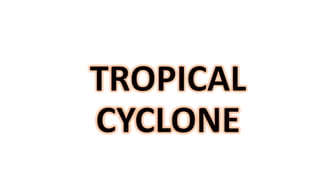
TROPICAL CYCLONE.pptx
- 2. The location of the Philippines makes it prone to experience typhoons. The country is located just above the equator, along the west Pacific Ocean, where it receives enough heating from the sun, causing the surrounding bodies of water to warm up. This leads to the development of low-pressure areas which eventually turns into tropical cyclones.
- 6. •When tropical cyclones stay/cross warm waters, it intensifies as it is continuously supplied by rising warm air and high humidity. • Upon reaching landfall, it weakens as it faces cool dry air and move over large land mass. The mountain ranges and forest rich in trees increase the friction encountered by tropical cyclones causing it to weaken and block the moisture in the wind making the air masses dry.
- 7. •Additionally, its strength lessens as it travels over cooler sea surface temperature and move to regions with high vertical wind shear. Generally, tropical cyclones move in a westward direction along with the prevailing wind systems. This often spares Central and Southern Mindanao from typhoons but is still susceptible to weather disturbances which may bring more rain because of the surrounding bodies of water
- 8. •Usually move from East-West across the country, heading North or West •Monitored by PAGASA (Philippine Atmospheric, Geophysical and astronomical Service Administration) •About 20 tropical cyclones enter the PAR each year
- 10. •Peak of the typhoon season is July-October, when nearly 70% of all typhoon develop •Philippines is the most exposed country in the world •Tropical Cyclones entering the PAR are given local names by the PAGASA which also raises public storm warning signals •PAGASA prepares 25 names in each set
- 12. •2 separate agencies that assign names to tropical cyclones which can often result having 2 names •The JMA (Japan Meteorological Agency) will name a tropical cyclone based on its sustained wind speeds of at least 65kph
- 13. • Typhoon Ketsana- Ondoy (2009) 165 kph • Tropical Storm Washi – Sendong (2011) • Super Typhoon Haiyan – Yolanda (2013) 315 kph killing more than 6,000 people, displacing 4.1 million people, 1,800 missing and 12,000 were injured
- 14. •PAGASA assign names to tropical depression in the PAR located between 135° East -115° East and between 5 ° North -25 ° North regardless of whether or not a tropical cyclone has already been given a name by JMA
- 15. •Set of names or the bagyo or typhoon are taken after the contest “Name a Bagyo Contest” conducted by the PAGASA in 1998 •Retiring names if it caused at least ₽ 1 billion damage or have at least 300 deaths within the Philippines and names with negative associations with real persons
- 16. NDRRMC National Disaster Risk Reduction and Management Council •Each province and local government in the Philippines has a corresponding Disaster Risk Reduction and Management Office (DRRMO) •Preparation and response to typhoons •Warning signals, guiding activities in the field of communication, rescue, engineering, health, rehabilitation and public education
- 23. ASSESSMENT
- 24. • 1. What is the shape of the Philippine Area of Responsibility (PAR)? A. C. B. D.
- 25. • 2. Which of the following correctly describes the Philippine Area of Responsibiltiy? A. All LPA within the PAR are called bagyo. B. PAGASA does not monitor outside PAR. C. Western boundary is much farther than the eastern. D. Eastern boundary is much farther than the western.
- 26. •3. Which government agency monitors weather disturbances? A. Philippine Volcanology and Seismology B. Philippine Institute of Volcanology and Seismology C. Philippine Astronomic, Geophysical, and Atmospherical Services Administration D. Philippine Atmospheric, Geophysical, and Astronomical Services Administration
- 27. •4. A weather forecaster reports that a typhoon will enter the PAR at 6:00AM tomorrow. What does this mean? A. The typhoon will be closely monitored by PAGASA for possible landfall. B. The typhoon will become stronger at 6:00 AM tomorrow. C. The typhoon will become weaker at 6:00 AM tomorrow. D. It will reach landfall by 6:00AM tomorrow.
- 28. • 5. If you live in the Philippines, where should you stay to avoid typhoons? A. Luzon, it is not on the path of typhoons. B. Visayas, it is at the middle. C. Visayas, it has a lot of mountain ranges. D. Mindanao, it is seldom affected by typhoons.
- 29. • 6. What does a typhoon need to sustain or increase its intensity? A. warm land B. warm water C. cold land D. cold water
- 30. •7. What will happen to the strength of the typhoon as it reaches land? A. It will move slowly to cause more damage. B. It will move faster to reach the warm water. C. It will weaken due to the absence of warm water. D. It will be stronger due to the absence of warm water
- 31. •8. How can forests filled with trees affect the strength of typhoons? A. Forests increases friction encountered by typhoons, reducing its strength. B. Forests increases friction encountered by typhoons, increasing strength. C. Forests decreases friction encountered by typhoons, increasing strength. D. Forests decreases friction encountered by typhoons, decreasing strength.
- 32. •9.Which area will be greatly affected by a storm surge? A. hillside B. shoreline C. caves D. city
- 33. •10.In what way can tropical cyclones be a benefit? A. Replenishes dams B. Increases air pollution C. Causes the sea level to rise D. Elevate water levels in rivers